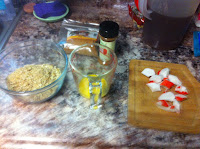17. Myths and Legends (August 12 - August 25) It’s time to make some legendary food! Pick a story from folklore (a myth, fantasy, legend, or fairy tale) that features food, and use a historical recipe to recreate it.
Intro
We're gonna take a quick break from the Friendly Sons of St. Patrick dinner to bring you a Legend from Irish culture and one of my favorite historic recipes.
Fionn MacCumhaill and the Salmon of Knowledge.
The legend goes that an ordinary salmon ate nine hazelnuts that had fallen into the Well of Knowledge. Whomever ate the fish would gain the knowledge of the world. As a young man Fionn was fostered with a wise poet named Finn Eces. After seven years, Finn Eces caught the Salmon of Knowledge. He left it with Fionn to cook with a firm admonishment not to eat any of it. When Finn Eces returned, he saw a certain look in young Fionn's eye and quizzed him about eating the fish. He confessed a drop of hot fat from the fish had burned his thumb, which he had stuck in his mouth. Finn Eces realized this counted as "eating from the fish of knowledge" and insisted Fionn finish the fish. The prophecy was fufilled and Fionn MacCumhaill became the warrior, leader, and wise-man he was meant to be.
The Recipe:
From: Cre-fydd's Family Fare: The Young Housewife's Daily Assistant by Simpkin, Marshall, &Co., 1864
50. SALMON IN POTATO PASTE.
(Second dressing.)
Mash six mealy potatoes with a wooden spoon till quite smooth, add two saltspoonfuls of salt, two ounces of oiled butter, and the yolk of an egg; beat till very light. Divide about half a pound of cold salmon into neat pieces an inch long, freed from skin and bone. Mix with it a saltspoonful of salt, a grain of cayenne, half a saltspoonful of white pepper, and three tablespoonfuls of shrimp sauce, or melted butter. Put a layer of potato into a flat dish, lay in the fish, cover it with the rest of the potato. Smooth over the top with a knife, and bake in a quick oven for twenty minutes. Serve in the same dish, which should be placed on a folded napkin on another dish.
The Date/Year and Region:
1850-1870, Great Britain and the United States
How Did You Make It:
First prepare the fish. Notice the "second dressing" designation? This indicates the dish is made of left-overs. In this case, I did oven-baked salmon cutlets with a seasoned gluten-free breadcrumb coating from my trusty Eliza Leslie's Lady's Receipt Book.
Next I steamed the potatoes.
Then I mashed the potatoes with salted butter and egg yolk.
Finally I'm ready to layer the dish.
Bake until the potatoes get crispy on the peaks.
Time to Complete:
About an hour, once the ingredients are assembled.
Total Cost:
The salmon was $10.00, so it's not the cheap dish it once was.
How Successful Was It:
It looked like a horror show from the 1960s Jello Cookbook, but it tastes great. I got to use my new fish mold pan and it un-molded well. Overall it's a success.
How Accurate Was It:
It's definitely "in the spirit, but I took a few departures. I used imitation crab instead of lobster. It was cheaper and we love us some crab in this household. I did only two layers and used a molded pan instead of a casserole dish. Since a celebratory dinner is my sub-goal for this year, I think a dressing up was appropriate. For me, I thought a molded piece would do so. Otherwise, the recipe was prepared as given and thus, I say the accuracy level is fairly high.
******************************************
Bonus Recipe:
From: The Lady's Receipt Book by Eliza Leslie, 1840
BAKED SALMON.--A small salmon may be baked whole. Stuff it with forcemeat made of bread-crumbs; chopped oysters, or minced lobster; butter; cayenne; a little salt, and powdered mace,--all mixed well, and moistened with beaten yolk of egg. Bend the salmon round, and put the tail into the mouth, fastening it with a skewer. Put it into a large deep dish; lay bits of butter on it at small intervals; and set it into the oven. While baking, look at it occasionally, and baste it with the butter. When one side is well browned, turn it carefully in the dish, and add more butter. Bake it till the other side is well browned. Then transfer it to another dish with the gravy that is about it, and send it to table.
If you bake salmon in slices, reserve the forcemeat for the outside. Dip each slice first in beaten yolk of egg, and then in the forcemeat, till it is well coated. If in one large piece, cover it in the same manner thickly with the seasoning.
The usual sauce for baked salmon is melted butter, flavoured with the juice of a lemon, and a glass of port wine, stirred in just before the butter is taken from the fire. Serve it up in a sauce-boat.
How Did You Make It:
Prepare the forcemeat
Layer the forcemeat on the salmon
Bake at 350* for 15 minutes
Yep, I really did have dinner barefoot. I'm quite classy that way sometimes. :-)

















































